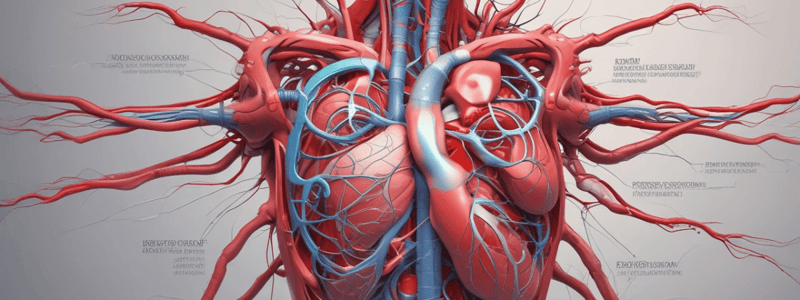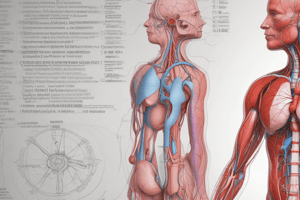Podcast
Questions and Answers
What is the main purpose of the cardiovascular system?
What is the main purpose of the cardiovascular system?
- To deliver oxygen and nutrients to the cells of the body (correct)
- To pump blood through the lungs
- To regulate body temperature
- To remove waste products from the body
What happens to the blood as it passes through the capillary bed?
What happens to the blood as it passes through the capillary bed?
- It becomes thicker and more viscous
- It gains oxygen and nutrients
- It loses oxygen and gains carbon dioxide (correct)
- It stays the same
What is the result of high pressure in the blood vessels?
What is the result of high pressure in the blood vessels?
- The blood vessels become larger
- The heart beats slower
- Fluid is absorbed back into the blood vessels
- Fluid is forced out of the blood vessels (correct)
What is the fluid that is forced out of the blood vessels?
What is the fluid that is forced out of the blood vessels?
What would happen if the fluid continued to accumulate outside the capillaries?
What would happen if the fluid continued to accumulate outside the capillaries?
What is the significance of the capillary bed having a large surface area?
What is the significance of the capillary bed having a large surface area?
Why does the heart need to pump strongly?
Why does the heart need to pump strongly?
What happens to the blood as it returns to the heart?
What happens to the blood as it returns to the heart?
What is the main function of the lymphatic system?
What is the main function of the lymphatic system?
What type of vessels does the lymphatic system consist of?
What type of vessels does the lymphatic system consist of?
What is the fluid that gets forced out of the blood vessels and into the lymphatic vessels?
What is the fluid that gets forced out of the blood vessels and into the lymphatic vessels?
Why do bigger proteins and red blood cells not get squeezed out of the capillary?
Why do bigger proteins and red blood cells not get squeezed out of the capillary?
What happens to the concentration of solutes in the latter part of the capillary?
What happens to the concentration of solutes in the latter part of the capillary?
What is the reason for the increased osmotic pressure in the latter part of the capillary?
What is the reason for the increased osmotic pressure in the latter part of the capillary?
What happens to the fluid and smaller proteins in the latter part of the capillary?
What happens to the fluid and smaller proteins in the latter part of the capillary?
What is the main force that pushes the lymph out of the blood vessel?
What is the main force that pushes the lymph out of the blood vessel?
What happens to the pressure in the latter part of the capillary compared to the earlier part?
What happens to the pressure in the latter part of the capillary compared to the earlier part?
What is the net result of the lymphatic system's function?
What is the net result of the lymphatic system's function?
What is the net result of blood traveling through a capillary?
What is the net result of blood traveling through a capillary?
Why do the endothelial cells in capillaries not tighten their connections to prevent fluid leakage?
Why do the endothelial cells in capillaries not tighten their connections to prevent fluid leakage?
What is a unique characteristic of oxygen that allows it to pass through the endothelial cells?
What is a unique characteristic of oxygen that allows it to pass through the endothelial cells?
What is the primary function of lymph vessels in the body?
What is the primary function of lymph vessels in the body?
What is a key difference between lymph vessels and blood vessels?
What is a key difference between lymph vessels and blood vessels?
What happens to the lymph that is collected by lymph vessels?
What happens to the lymph that is collected by lymph vessels?
Why are capillaries found throughout the body?
Why are capillaries found throughout the body?
What is the purpose of the gaps between endothelial cells in capillaries?
What is the purpose of the gaps between endothelial cells in capillaries?
Flashcards are hidden until you start studying
Study Notes
The Cardiovascular System
- The heart pumps blood through blood vessels in a closed loop to deliver oxygen and nutrients to cells throughout the body.
- The purpose of the cardiovascular system is to get blood to capillary beds, where oxygen and nutrients are exchanged with cells.
Capillary Beds
- Capillary beds are areas where blood vessels become very thin and divide, increasing surface area for oxygen and nutrient exchange with cells.
- Oxygen is transferred from the blood to cells, and carbon dioxide is transferred from cells to the blood.
- Deoxygenated blood returns to the heart, where it is pumped to the lungs to pick up oxygen.
Blood Pressure and Fluid Exchange
- High blood pressure in the heart and blood vessels forces fluid out of the vessels, especially in capillaries.
- The fluid forced out is plasma, which is the liquid part of blood, and some smaller proteins.
- Red blood cells and larger proteins are too big to be squeezed out of the vessels.
The Lymphatic System
- The lymphatic system is a separate plumbing system that collects fluid forced out of blood vessels and returns it to the blood circulation.
- Lymphatic vessels collect fluid and proteins from capillaries and return them to the blood, maintaining a sustainable situation.
- Lymphatic vessels do not form a closed loop like blood vessels, but rather dump their contents back into the blood circulation.
Fluid Exchange in Capillaries
- In capillaries, fluid is forced out of the blood vessel due to high pressure.
- The endothelial cells lining the capillary are not tightly connected, allowing fluid and small proteins to pass through.
- The concentration of solutes is higher in the latter part of the capillary, leading to a higher osmotic pressure that pulls fluid back in.
- Although some fluid is pulled back into the capillary, more fluid is pushed out, resulting in a net loss of fluid.
Importance of Fluid Exchange
- Fluid exchange in capillaries is necessary to deliver oxygen, nutrients, and hormones to cells throughout the body.
- Oxygen can diffuse through the walls of capillaries and endothelial cells to reach cells.
- The gaps between endothelial cells allow for the exchange of small molecules like glucose and hormones.
Lymph Vessels
- Lymph vessels are found throughout the body, collecting lymph from capillaries and returning it to the blood circulation.
- Lymph vessels start small and merge together, eventually dumping their contents back into the blood circulation.
- The lymphatic system is necessary to collect and return fluid to the blood circulation, preventing a buildup of fluid in tissues.
Studying That Suits You
Use AI to generate personalized quizzes and flashcards to suit your learning preferences.




